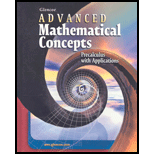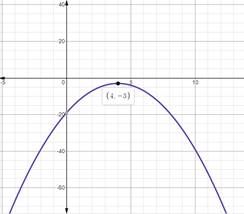
Concept explainers
a.
To find: the intervals where
a.
Answer to Problem 36E
Explanation of Solution
Given information:
A line is secant to the graph of
Calculation:
Plot the graph using a graphing calculator as look for the point of

The graph is increasing from
b.
To find: slope of the secant line that passes through any two points contained in the interval evaluated in part a.
b.
Answer to Problem 36E
5
Explanation of Solution
Given information:
A line is secant to the graph of
The increasing intervals evaluated in part a. are
Calculation:
The two point selected from the increasing interval to find the slope are
Now put the
Thus, the slope of the secant line is 5.
c.
To make: a conjecture about the slope of any secant line that passes through any two points contained in the interval evaluated in part a.
c.
Answer to Problem 36E
The slope of any line made on an interval where the graph is increasing will be positive.
Explanation of Solution
Given information:
A line is secant to the graph of
Calculation:
If the slope is found for any two points on increasing interval of function, then the secant line will always move up and to the right because one of the points will always be above and to the right of the other point. Any line moving up and to the right has a positive slope.
d.
To find: the intervals where
d.
Answer to Problem 36E
Explanation of Solution
Given information:
A line is secant to the graph of
Calculation:
Plot the graph using a graphing calculator as look for the point of maxima in the graph. The graph of

The graph is decreasing from
e.
To make: a hypothesis about the slope of any secant line that passes through any two points contained in the interval evaluated in part d, and explain your reason.
e.
Answer to Problem 36E
The slope of any line made on an interval where the function is decreasing will be negative.
Explanation of Solution
Given information:
A line is secant to the graph of
Calculation:
If the slope is found for any two points on decreasing interval of function, then the secant line will always move down and to the right because one of the points will always be lower and to the right of the other point. Any line moving down and to the right has a negative slope.
The two point selected from the decreasing interval to find the slope are
Now put the points in the slope formula and evaluate m as follows:
The slope of the secant line evaluated is
Chapter 3 Solutions
Advanced Mathematical Concepts: Precalculus with Applications, Student Edition
Additional Math Textbook Solutions
University Calculus: Early Transcendentals (4th Edition)
Single Variable Calculus: Early Transcendentals (2nd Edition) - Standalone book
University Calculus: Early Transcendentals (3rd Edition)
Precalculus (10th Edition)
Thomas' Calculus: Early Transcendentals (14th Edition)
 Calculus: Early TranscendentalsCalculusISBN:9781285741550Author:James StewartPublisher:Cengage Learning
Calculus: Early TranscendentalsCalculusISBN:9781285741550Author:James StewartPublisher:Cengage Learning Thomas' Calculus (14th Edition)CalculusISBN:9780134438986Author:Joel R. Hass, Christopher E. Heil, Maurice D. WeirPublisher:PEARSON
Thomas' Calculus (14th Edition)CalculusISBN:9780134438986Author:Joel R. Hass, Christopher E. Heil, Maurice D. WeirPublisher:PEARSON Calculus: Early Transcendentals (3rd Edition)CalculusISBN:9780134763644Author:William L. Briggs, Lyle Cochran, Bernard Gillett, Eric SchulzPublisher:PEARSON
Calculus: Early Transcendentals (3rd Edition)CalculusISBN:9780134763644Author:William L. Briggs, Lyle Cochran, Bernard Gillett, Eric SchulzPublisher:PEARSON Calculus: Early TranscendentalsCalculusISBN:9781319050740Author:Jon Rogawski, Colin Adams, Robert FranzosaPublisher:W. H. Freeman
Calculus: Early TranscendentalsCalculusISBN:9781319050740Author:Jon Rogawski, Colin Adams, Robert FranzosaPublisher:W. H. Freeman
 Calculus: Early Transcendental FunctionsCalculusISBN:9781337552516Author:Ron Larson, Bruce H. EdwardsPublisher:Cengage Learning
Calculus: Early Transcendental FunctionsCalculusISBN:9781337552516Author:Ron Larson, Bruce H. EdwardsPublisher:Cengage Learning





